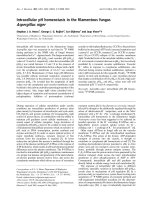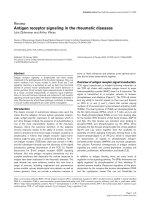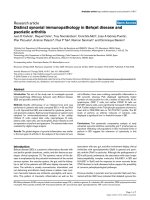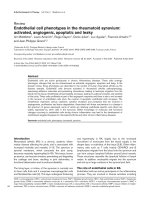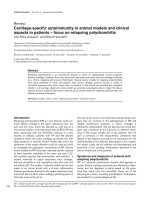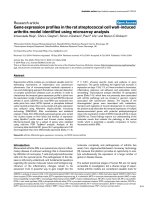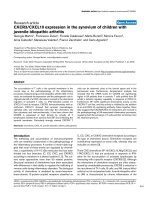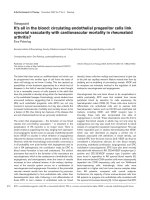Báo cáo y học: " Glutathione S-transferase omega in the lung and sputum supernatants of COPD patients" potx
Bạn đang xem bản rút gọn của tài liệu. Xem và tải ngay bản đầy đủ của tài liệu tại đây (673.59 KB, 9 trang )
BioMed Central
Page 1 of 9
(page number not for citation purposes)
Respiratory Research
Open Access
Research
Glutathione S-transferase omega in the lung and sputum
supernatants of COPD patients
Terttu H Harju
1
, Mirva J Peltoniemi
1,2
, Paula H Rytilä
3
, Ylermi Soini
6,8
,
Kaisa M Salmenkivi
4
, Philip G Board
5
, Lloyd W Ruddock
2
and
Vuokko L Kinnula*
7
Address:
1
Department of Internal Medicine, University of Oulu, Oulu, Finland,
2
Biocenter Oulu and Department of Biochemistry, University of
Oulu, Oulu, Finland,
3
Department of Medicine, Division of Allergology, University of Helsinki, Helsinki, Finland,
4
Department of Pathology,
Helsinki University Hospital, Helsinki, Finland,
5
John Curtin School of Medical Research, Australian National University, Canberra, Australia,
6
Department of Pathology, Oulu University Hospital, Oulu, Finland,
7
Department of Medicine, Division of Pulmonary Diseases, University of
Helsinki and Helsinki University Hospital, Helsinki, Finland and
8
Department of Clinical Pathology and Forensic Medicine, University of Kuopio,
Kuopio, Finland
Email: Terttu H Harju - ; Mirva J Peltoniemi - ; Paula H Rytilä - ;
Ylermi Soini - ; Kaisa M Salmenkivi - ; Philip G Board - ;
Lloyd W Ruddock - ; Vuokko L Kinnula* -
* Corresponding author
Abstract
Background: The major contribution to oxidant related lung damage in COPD is from the
oxidant/antioxidant imbalance and possibly impaired antioxidant defence. Glutathione (GSH) is one
of the most important antioxidants in human lung and lung secretions, but the mechanisms
participating in its homeostasis are partly unclear. Glutathione-S-transferase omega (GSTO) is a
recently characterized cysteine containing enzyme with the capability to bind and release GSH in
vitro. GSTO has not been investigated in human lung or lung diseases.
Methods: GSTO1-1 was investigated by immunohistochemistry and Western blot analysis in 72
lung tissue specimens and 40 sputum specimens from non-smokers, smokers and COPD, in
bronchoalveolar lavage fluid and in plasma from healthy non-smokers and smokers. It was also
examined in human monocytes and bronchial epithelial cells and their culture mediums in vitro.
Results: GSTO1-1 was mainly expressed in alveolar macrophages, but it was also found in airway
and alveolar epithelium and in extracellular fluids including sputum supernatants, bronchoalveolar
lavage fluid, plasma and cell culture mediums. The levels of GSTO1-1 were significantly lower in the
sputum supernatants (p = 0.023) and lung homogenates (p = 0.003) of COPD patients than in non-
smokers.
Conclusion: GSTO1-1 is abundant in the alveolar macrophages, but it is also present in
extracellular fluids and in airway secretions, the levels being decreased in COPD. The clinical
significance of GSTO1-1 and its role in regulating GSH homeostasis in airway secretions, however,
needs further investigations.
Published: 6 July 2007
Respiratory Research 2007, 8:48 doi:10.1186/1465-9921-8-48
Received: 29 January 2007
Accepted: 6 July 2007
This article is available from: />© 2007 Harju et al; licensee BioMed Central Ltd.
This is an Open Access article distributed under the terms of the Creative Commons Attribution License ( />),
which permits unrestricted use, distribution, and reproduction in any medium, provided the original work is properly cited.
Respiratory Research 2007, 8:48 />Page 2 of 9
(page number not for citation purposes)
Background
Several studies suggest the importance of oxidative stress
in the pathogenesis of chronic obstructive pulmonary dis-
ease (COPD). Cigarette smoke not only contains high lev-
els of oxidants, but it also activates oxidant producing
pathways in the lungs [1,2]. The oxidant/antioxidant
imbalance present in the lungs of these patients also
results from the impaired capacity of the antioxidant/
detoxification enzymes to detoxify the harmful reactive
oxygen metabolites [3-8]. Very little is known about spe-
cific changes in the major antioxidant defence mecha-
nisms in mild or severe COPD.
One of the major antioxidants in human airways is glu-
tathione (GSH) (L-γ-glutamyl-L-cysteinyl-glycine); how-
ever the regulatory mechanisms controlling the intra- and
extra-cellular concentrations of GSH are not completely
understood [9-11]. The rate limiting enzyme in GSH bio-
synthesis, glutamate cysteine ligase (GCL) is induced by
cigarette smoke [12], but controversially shown to either
increase or decrease in COPD [5,13,14]. GCL levels alone
do not explain the changes observed in the free GSH levels
of airways in smokers or COPD [7]. Other enzymes that
can participate in GSH homeostasis in the lung and air-
way secretions include glutathione peroxidases (Gpx); for
example Gpx2 is induced in experimental mice model by
smoke exposure [15] and Gpx3 is increased in the bron-
chial epithelium and epithelial lining fluid of smokers
[16]. Another additional group of enzymes that is associ-
ated with GSH homeostasis in human airways is glutare-
doxin (Grx) family of enzymes. The classical member of
this family, Grx1, is regulated in bronchial epithelial cells
by oxidants and cigarette smoke in vitro [8], but has also
been shown to be present in the extracellular fluids
including sputum supernatants [17-19]. One important
function of glutaredoxins is their thioltransferase activity
and the subsequent effects on the glutathionylation state
of proteins in the lung. It has become apparent that there
is another thioltransferase i.e. glutathione-S-transferase
omega (GSTO) in mammalian cells which may have
potential role in regulating GSH homeostasis. This
enzyme belongs to the glutathione-S-transferase family
(GST) that detoxify toxic substrates present in tobacco
smoke by a GSH-dependent mechanism [20,21]. GSTO
contains an N-terminal glutathione-binding domain sug-
gesting its role in the metabolism and maintenance of
GSH levels in intact cells [20,22]. Since GSH is one of the
major antioxidants of the airways, it can be hypothesized
that GSTO may participate in the maintenance of GSH not
only intracellularly, but also in the extracellular space and
this may be modulated by oxidative stress.
The present study was undertaken 1) to investigate the cell
specific distribution and expression of GSTO1-1 in
healthy human lung, 2) to compare the GSTO1-1 expres-
sion patterns in the lung of non-smokers, smokers with-
out obstruction and smokers with variable severities of
COPD, 3) to assess whether GSTO1-1 is associated with
COPD severity and 4) to analyze whether GSTO1-1 can be
detected in airway secretions/induced sputum superna-
tants, bronchoalveolar lavage fluid (BALF) or plasma.
Methods
Tissue, induced sputum, bronchoalveolar lavage and
plasma specimens
Lung tissue specimens from 72 patients including 26 cur-
rent smokers with COPD, 22 current smokers with nor-
mal lung function, 16 life-long non-smokers undergoing
resection for lung tumour (local carcinoma or hamar-
toma) and 8 ex-smokers with severe COPD undergoing
lung transplantation were collected for immunohisto-
chemical studies from the archives of the Departments of
Pathology, Oulu University Hospital or Helsinki Univer-
sity Hospital. COPD was defined on the basis of preoper-
ative lung function: FEV1/FVC less than 70% and no
reversibility (bronchodilatation effect less than 12%)
according to GOLD criteria [23]. All lung transplant
patients with stage IV COPD were receiving inhaled corti-
costeroid therapy. All smokers were current smokers with
the exception of lung transplant patients, who were all ex-
smokers. The clinical characteristics of the patients in the
immunohistochemical studies are shown in Table 1. Tis-
Table 1: The characteristics of the patients in the immunohistochemistry studies
Non-smoker N = 16 Smoker N = 22 COPD N = 34 p-value
Age, years 65 (13) 63 (8) 62 (9) 0.543
Sex M:F 8:8 17:5 27:7 0.103
Pack-years 0 46 (19) 38 (13)* 0.000
FEV1 %predicted 98 (15) 90 (10) 55 (23) 0.000
FEV1/FVC % 86 (9) 83 (11) 56 (15) 0.000
MEF50 %pred 94 (24) 80 (37) 34 (21) 0.000
DCO %pred 91 (15) 78 (14) 64 (27) 0.004
DCO/VA %pred 89 (11) 83 (12) 72 (24) 0.035
Mean (SD)
*In post-hoc comparison only the alpha-1-antitrypsin group differed from smokers and other COPD-groups with mean pack-years of 18 (SD 9)
years.
Respiratory Research 2007, 8:48 />Page 3 of 9
(page number not for citation purposes)
sues for the Western analyses had been frozen immedi-
ately in liquid nitrogen after the surgery, and
homogenized in ice cold phosphate buffered saline (PBS);
the clinical characteristics of these patients are presented
in Table 2. A total of 8 patients in the COPD group (two
patients with stage I-II COPD and 6 lung transplant cases
with stage IV COPD) were receiving inhaled corticosteroid
therapy. None of the subjects had received N-acetyl-
cysteine treatment.
Sputum was induced by inhalation of 4.5% hypertonic
saline given at 5-minute intervals for a maximum of 20
minutes according to the guidelines of the European Res-
piratory Society's Task Force [24]. The characteristics of
the patients selected for the studies on induced sputum
specimens are shown in Table 3.
Bronchoalveolar lavage (BAL) had been obtained from 3
non-smokers and 3 smokers who had been investigated
for minor respiratory symptoms of unknown etiology.
Fiberoptic bronchoscopy for sampling BAL fluid was per-
formed under local anaesthesia with lignocaine and the
fluid was collected after installation of 10 aliquots of 20
ml from the right middle lobe. The cytocentrifuge prepa-
ration indicated a normal cell differential count with over
90% of the cells being macrophages. After centrifugation
(400 × g for 15 minutes), the cells and supernatant were
collected, frozen and stored at -80 C.
Plasma samples were collected from 4 non-smokers, 4
healthy smokers and 4 patients with stage I-II COPD.
Cell cultures
Human histiocytic lymphoma (U937) cells were obtained
from the American Type Culture Collection [25]. The cells
were cultured in RPMI 1640 supplemented with 10% fetal
bovine serum, 100 units/ml penicillin, and 100 μg/ml
streptomycin. Monocyte-macrophage differentiation was
induced by phorbol 12-myristate 13-acetate (PMA) at
concentrations of 100 ng/ml. Human non-malignant
bronchial epithelial (BEAS-2B) cells (American Type Cul-
ture Collection, Rockville, MD, USA) were cultured in
Bronchial Epithelial Growth Medium (BEGM) (Clonetics
Corporation, Walkersville, MD, USA) and subcultured
before reaching confluence.
Immunohistochemistry and cytochemistry of GSTO1-1 in
the tissues and sputum specimens
One tissue block from each patient was selected from
peripheral lung. Four-μm sections were cut for immuno-
histochemical analysis. The sections were deparaffinized
in xylene and rehydrated in a descending ethanol series.
Endogenous peroxidase was blocked by incubating the
sections in 3% hydrogen peroxide in absolute methanol
for 15 minutes. The sections were incubated with the pri-
mary antibody for GSTO1-1 using a dilution of 1:200. The
immunostaining was done using the Histostain-Plus Kit
(Zymed Laboratories Inc., San Francisco, CA), and the
chromogen was aminoethyl carbazole (AEC) (Zymed
Laboratories Inc.). In negative controls, the primary anti-
body was substituted with phosphate-buffered saline
(PBS) or rabbit primary antibody isotype control from
Zymed Laboratories Inc.
The number of macrophages was calculated using the
Zeiss AxioHOME Morphometry program (Zeiss, Jena,
Germany). GSTO-positive macrophages were counted by
two techniques and by three investigators, first by calcu-
lating the number in 10 high power fields of the specimen
(YS) and secondly by using the Zeiss AxioHOME Mor-
phometry program (Zeiss) (PR, KS). Immunoreactivity
was also assessed semiquantitatively by grading the stain-
ing intensity of the macrophages, bronchial, bronchiolar
or alveolar epithelium or vascular endothelium as nega-
tive (0), weak (1) or moderate/intense (2) (YS). GSTO1-1
positive and negative cells in the sputum specimens were
counted (400 cells/cytospin).
The cytospin samples were treated with Ortho Permeafix
(Ortho Diagnostic Systems Inc., UK) and for immunos-
taining, Zymed ABC Histostain-Plus Kit was used accord-
ing to the manufacturer's protocol. The samples were
Table 2: The characteristics of the patients in Western blotting for whole lung homogenates
Non-smoker N = 9 Smoker N = 5 COPD N = 17 p-value
Age, years 62 (13) 60 (3) 61 (9) 0.0917
Sex M:F 4:5 4:1 13:4 0.350
Pack-years 0 41 (14) 35 (15)* 0.000
FEV1 %predicted 99 (20) 84 (14) 50 (28) 0.000
FEV1/FVC % 88 (6) 81 (7) 55 (17) 0.008
MEF50 %pred 94 (29) 84 (61) 37 (20) 0.009
DCO %pred 92 (18) 81 (11) 54 (22) 0.002
DCO/VA %pred 98 (18) 88 (1) 61 (22) 0.002
Mean (SD)
*In post-hoc comparison no significant differences were found between smokers and the COPD-groups considering pack-years.
Respiratory Research 2007, 8:48 />Page 4 of 9
(page number not for citation purposes)
incubated with an antibody against GSTO1-1 and nega-
tive control samples with Zymed Rabbit Isotype Control
and PBS, and stained with AEC (Zymed Laboratories Inc.)
and thereafter with Mayer's haematoxylin.
Western blot analysis
Western blot analysis from tissue homogenates and spu-
tum supernatants was conducted as described earlier [22]
with 1:2000–1:5000 dilution of GSTO1-1 antibody. In
previous studies from our laboratory and others
[17,26,27] β-actin has shown high individual variability,
especially in tissue samples from the diseased lung.
Instead of using β-actin as a loading control, the protein
concentration was measured carefully as triplicates and
equal loading was ensured by staining the blotted mem-
branes with Ponceau S (Sigma Aldrich, St. Louis, MO,
USA).
Statistical methods
The statistical analyses were performed with the SPSS for
Windows software (SPSS, Chicago, IL, USA). Continuous
data were compared using analysis of variance (ANOVA).
When ANOVA results indicated that groups differed, post
hoc comparisons were performed using two-tailed t-tests.
Categorical data were compared using Fisher's exact test
designed for small sample groups. P-values less than 0.05
were considered statistically significant. Correlations to
lung functions were analyzed with the Pearson correlation
test.
Ethical considerations
The study protocol was approved by the ethical commit-
tees of Oulu University Hospital and Helsinki University
Hospital and it is in accordance with the ethical standards
of the Helsinki declaration of 1975.
Results
Immunohistochemistry from the tissue specimens
GSTO1-1 was mainly expressed in alveolar macrophages
(Figure 1). One typical feature of COPD is the accumula-
tion of macrophages to the lung. Probably due to the low
numbers of the cases and high variability in the numbers
of alveolar macrophages, the post-hoc comparison was
significant only between non-smokers and stage I-II
COPD. (Figure 2A)
The number of GSTO1-1 positive macrophages/surface
area (mm
2
) were then evaluated, but the percentages of
GSTO1-1 positive macrophages did not differ between
non-smokers, smokers and COPD-patients (p = 0.085).
When the COPD group was divided into stages I-II and IV
COPD, the difference between the groups was significant
(p = 0.004). The mean (SD) percentage of GSTO1-1 posi-
tive macrophages in non-smokers was 40 (30), smokers
19 (25), COPD stage I-II 24 (26) and COPD stage IV 58
(36) and the mean difference was significant at 0.05 level
between stage IV COPD and smokers and between stage
IV and stage I-II COPD (Figure 2B). The intensity of the
GSTO1-1 immunoreactivity in alveolar macrophages var-
ied, being moderate/intense in 8/16 non-smokers, 9/22
Immunohistochemical staining for GSTO1-1 (1:200) in the peripheral lung of non-smoker (A), COPD stage I-II (B) and COPD stage IV (C)Figure 1
Immunohistochemical staining for GSTO1-1 (1:200) in the
peripheral lung of non-smoker (A), COPD stage I-II (B) and
COPD stage IV (C). Negative control, COPD stage IV (D).
GSTO1-1 was mainly expressed in alveolar macrophages.
Table 3: The characteristics of the patients in the sputum study
Non-smoker N = 6 Smoker N = 5 COPD N = 15 p-value
Age, years 59 (3) 52 (6) 63 (8) 0.06
Sex M:F 4:2 4:1 8:7 0.103
Pack-years 0 28 (11) 47 (12) 0.000
FEV1 %predicted 107 (6) 102 (15) 62 (18) 0.001
FEV1/FVC % 83 (5) 82 (5) 64 (10) 0.001
MEF50 %pred 99 (12) 103(12) 31 (19) 0.001
DCO %pred 96(10) 84 (13) 65 (12) 0.001
DCO/VA %pred 101 (12) 102 (6) 76 (17) 0.003
Mean (SD)
Respiratory Research 2007, 8:48 />Page 5 of 9
(page number not for citation purposes)
smokers and 23/31 COPD-patients. Bronchial and
bronchiolar epithelium was either negative or weak (65/
69), but by immunohistochemistry the alveolar epithe-
lium was always positive in stage IV COPD. The intensi-
ties of GSTO1-1 in various lung cells in healthy and
diseased lung including all stages of COPD are shown in
Figure 3.
There was a negative correlation between FEV1 and % of
GSTO1-1 positive macrophages in all COPD cases (r = -
0.533, p = 0.002) and in severe COPD (r = -0.794, p =
0.011). There was no correlation between the pack-years
or the dosage of inhaled corticosteroid and percentage
of GSTO1-1 positive macrophages.
Induced sputum extracellular fluids and tissue
homogenates
Macrophages in the induced sputum exhibited positive
GSTO1-1 reactivity (Figure 4) while neutrophils and
lymphocytes were negative. Importantly GSTO1-1 could
The GSTO1-1 immunoreactivity was most prominent in alve-olar macrophages varying from negative to moderate/intense and GSTO1-1 expression was either absent or weak in other cell typesFigure 3
The GSTO1-1 immunoreactivity was most prominent in alve-
olar macrophages varying from negative to moderate/intense
and GSTO1-1 expression was either absent or weak in other
cell types. Alveolar epithelium was always positive in stage IV
COPD. Bars represent means, error bars standard error of
mean.
Non-smoker Smoker St I-II COPD St IV COPD
Macrophages
Alveolar epithelium
Bronchial epithelium
Endothelium
1
2
0.5
1.5
2.5
*
Immunoreactivity
A. The numbers of alveolar macrophages were increased in smokers and in stage I-II COPD compared to non-smokers and stage IV COPD (p = 0.009)Figure 2
A. The numbers of alveolar macrophages were increased in smokers and in stage I-II COPD compared to non-smokers and
stage IV COPD (p = 0.009). The post-hoc comparison was significant at 0.05 level between non-smokers and stage I-II COPD
(*). B. The mean percentage of GSTO1-1 positive macrophages was higher in severe stage IV COPD compared to smokers or
COPD stage I-II (p = 0.004). The difference between non-smokers and other groups was not statistically significant. The post-
hoc comparison was significant at 0.05 level between stage IV COPD and smokers and between stage IV and stage I-II COPD
(*).
Respiratory Research 2007, 8:48 />Page 6 of 9
(page number not for citation purposes)
also be detected in the sputum supernatants while intrac-
ellular markers such as β-actin and some other antioxi-
dant enzymes such as manganese superoxide dismutase in
these specimens were negative (not shown). Western blot
analysis for GSTO1-1 showed decreased levels of GSTO1-
1 in the supernatants of COPD patients compared to non-
smokers (p = 0.023) (Figure 5A). These results suggest that
GSTO1-1 is excreted to the extracellular fluids both in
healthy lung and COPD.
To confirm the presence of GSTO1-1 in extracellular flu-
ids, GSTO1-1 was analyzed also from plasma and BALF
samples of non-smokers and smokers and from the medi-
ums of the cell cultures (U937 and BEAS2B). GSTO1-1
could be detected in all of samples (representative sam-
ples are shown in Figure 5B,5C). Tissue homogenates that
contain both lung cells and extracellular matrix, exhibited
a lower level of GSTO1-1 in the specimens obtained from
the COPD cases compared to the non-smokers and smok-
ers with normal lung function (p = 0.003) (Fig 5D). In
Western analysis, there was no correlation between the
lung function parameters and relative intensity in the lung
homogenates
Discussion
Glutathione related mechanisms that function both intra-
and extracellularly are known to be crucial in the pulmo-
nary defense against oxidants and probably also against
cigarette smoke. Here we show that GSTO1-1 has a highly
specific localization in the lung, being expressed mainly
in alveolar macrophages, but also weakly in other cell
types such as airway/alveolar epithelial cells. Importantly
GSTO1-1 could also be detected in extracellular fluids
including sputum supernatants, BALF, plasma and the cell
culture mediums of cultured monocytes and bronchial
epithelial cells. This finding strongly supports the idea
A. Western blotting for GSTO1-1 in induced sputum of non-smokers, smokers and COPD-patients showed an decreased immunoreacitivity in patients with COPD compared to non-smokers (p = 0.023)Figure 5
A. Western blotting for GSTO1-1 in induced sputum of non-
smokers, smokers and COPD-patients showed an decreased
immunoreacitivity in patients with COPD compared to non-
smokers (p = 0.023). B. GSTO1-1 could be detected in the
plasma samples and bronchoalveolar lavage fluid. Representa-
tive Western blots from three non-smokers are shown. C.
GSTO1-1 was also expressed in the culture medium of U937
monocytes and BEAS-2B cells. D. Lung tissue homogenates
showed higher level of GSTO1-1 in the specimens obtained
from non-smokers or smokers with normal lung function
when compared to COPD, p = 0.003.
Macrophages in induced sputum exhibited positive GSTO1-1 reactivityFigure 4
Macrophages in induced sputum exhibited positive GSTO1-1
reactivity. Representative sputum cytospins from a smoker
(A) and stage II COPD (B) are shown.
Respiratory Research 2007, 8:48 />Page 7 of 9
(page number not for citation purposes)
that the regulation of the GSH homeostasis is not only
regulated by intracellular antioxidant enzymes, but is
associated with extracellular thiol-modulating proteins
that participate in GSH binding and release.
Previously the distribution of GSTO1-1 has been investi-
gated in one human study [21] which showed it to be
abundant in a wide range of normal tissues, particularly in
the liver but also in the lung (three specimens); in the lung
GSTO1-1 could be found only in macrophages. The
results of the present study are in line with these findings,
but also found GSTO1-1 immunoreactivity in the bron-
chial and alveolar epithelium. The immunoreactivity was
also confirmed in BEAS-2B bronchial epithelial cells in
culture.
GSTO1-1 was also detectable in extracellular fluids such as
induced sputum supernatants, BALF, plasma and cell cul-
ture mediums. Previous studies have already indicated
that GSTO1-1 is highly expressed in the liver, suggesting
that plasma GSTO1-1 positivity may also be associated
with hepatic secretion. All sputum and BALF supernatants
were positive for GSTO1-1, but negative for several other
markers of intracellular proteins including β-actin. Over
80% of the cells were viable which also argues against any
leakage of GSTO1-1 through damaged cell membranes. It
is therefore possible that GSTO1-1 is similar to Grx1, in
being able to be excreted into the airways where it can par-
ticipate in the maintenance of GSH homeostasis. GSH lev-
els are increased in the BAL fluid representing epithelial
lining fluid (ELF) of cigarette smokers [28], but decreased
in the ELF during COPD exacerbations [29]. At present the
regulation of GSH in the airway secretions/ELF is far from
clear, but GSH synthesis in the ELF is very unlikely to
occur. Significant amounts of GSH may be present, how-
ever, as protein-GSH mixed disulfides that are known to
accumulate during oxidative stress both intracellularly
and to the extracellular space [30]. GSTO1-1 is one poten-
tial enzyme capable of participating in these reactions: it
contains cysteine in its active site where Cys32 can form a
disulphide bond with GSH and thereby function as a
potential reservoir of GSH during oxidative stress. Previ-
ous structural studies have indicated that the active site of
GSTO1-1 is relatively open and could potentially accom-
modate glutathionylated protein structures [31] though
the capacity of these reactions is probably diminished in
COPD. Overall the regulation of GSH maintenance, bind-
ing of GSH to proteins, its oxidation and release is com-
plicated. This study significantly extends earlier
observations on these pathways and importance of extra-
cellular fluids in these reactions; summary of these reac-
tions has been gathered to Figure 6.
Tissue studies showed elevated percentage of GSTO1-1
positive macrophages in peripheral lung in severe COPD
compared to smokers or stage I-II COPD with negative
correlation to lung function parameters. Furthermore,
alveolar epithelium was always found to be GSTO1-1 pos-
itive in severe COPD. These results may refer to continu-
ing efforts to protect inflamed, remodelled alveolar
epithelium and possibly also macrophages against oxida-
tive stress. Overall the synthesis/level of GSTO1-1 may be
enhanced in smoker's lung/COPD but together with other
antioxidant enzymes is not sufficient to maintain ade-
quate levels of free GSH against oxidative stress.
Tissue homogenates that contain both the cells and matrix
showed decreased levels of GSTO1-1 in COPD. These
changes in the GSTO1-1 levels in COPD may be partly
associated both with decreased levels of macrophages in
severe COPD, but also with the presence of all tissue com-
Suggested role of GSTO (glutathione transferase omega) in cigarette smoke induced oxidative stressFigure 6
Suggested role of GSTO (glutathione transferase omega) in
cigarette smoke induced oxidative stress. Enzymes maintain-
ing GSH homeostasis are important in protecting lung against
cigarette smoke induced oxidative stress. GSTO belongs to
the glutathione-S-transferase family (GST) that detoxifies
toxic substrates present in tobacco smoke by a GSH-
dependent mechanism. GSTO contains an N-terminal glu-
tathione-binding domain and is able to bind and release GSH.
GSH is one of the major antioxidants in airway secretions,
and it can be hypothesized that GSTO participates in the
maintenance of GSH homeostasis not only intracellularly but
also in the extracellular space. ROS, reactive oxygen species;
RNS, reactive nitrogen species; GSH, reduced glutathione;
GSSG, oxidized glutathione; GR glutathione reductase; GCL,
glutamate cysteine ligase; Grx, glutaredoxin; Prxe, peroxire-
doxin, GPXe, glutathione peroxidase (extracellular); GSX,
glutathione; ECSOD, extracellular superoxide dismutase;
GSNO, nitrosoglutathione; GS, glutathione syntethase.
Respiratory Research 2007, 8:48 />Page 8 of 9
(page number not for citation purposes)
ponents including the matrix in the lung homogenates
and lowered GSTO1-1 levels in the extracellular space.
In summary, this study significantly extends earlier under-
standing about the antioxidant defence in human lung
and extracellular fluids. The important new finding of the
presence of GSTO1-1 in extracellular fluids will require
further investigation to elucidate the role of GSTO1-1
there since the regulation of GSH levels in these fluids is
still poorly understood. The regulation of GSTO is also
unknown and there is no literature concerning the effect
of oxidative stress on GSTO expression. This is also a crit-
ical area requiring research in future investigations.
Competing interests
The authors declare that they have no competing interests.
The study has not been supported by tobacco industry.
Authors' contributions
THH participated in the design of the study and selection
of patient material, performed part of the statistical anal-
ysis and drafted the manuscript. MJP carried out the West-
ern blotting studies, participated in analyzing the
immunohistochemical data, performed part of the statis-
tical analysis and helped to draft the manuscript. PHR par-
ticipated in selection and collection of patient material,
analyzing the immunohistochemical results and per-
formed part of the statistical analysis. YS and KMS partic-
ipated in selection of patient material and analyzing the
immunohistochemical results. PGB participated in the
design of the study, provided the antibody against
GSTO1-1 and helped to draft the manuscript. LWR partic-
ipated in study coordination and helped to draft the man-
uscript. VLK conceived the study, and participated in its
design and coordination and helped to draft the manu-
script. All authors have read and approved the final man-
uscript.
Acknowledgements
This work was supported by grants from the Finnish Anti-Tuberculosis
Association Foundation, Finnish Association of Respiratory Medicine, Sigrid
Juselius Foundation, Ahokas Foundation, the Australian National Health
and Medical Council, the Academy of Finland, the Magnus Ehrnrooth Foun-
dation, the Finnish Cultural Foundation and the Funding of Helsinki Univer-
sity Hospital (HUCH EVO). We are grateful to Ms Kirsi Kvist-Mäkelä, Ms
Tiina Marjomaa, Ms Heta Merikallio and Mr Manu Tuovinen for their excel-
lent technical assistance.
References
1. Langen RC, Korn SH, Wouters EF: ROS in the local and systemic
pathogenesis of COPD. Free Radic Biol Med 2003, 35:226-235.
2. Rahman I, MacNee W: Role of oxidants/antioxidants in smok-
ing-induced lung diseases. Free Radic Biol Med 1996, 21:669-681.
3. Golpon HA, Coldren CD, Zamora MR, Cosgrove GP, Moore MD,
Tuder RM, Geraci MW, Voelkel NF: Emphysema lung tissue gene
expression profiling. Am J Respir Cell Mol Biol 2004, 31:595-600.
4. Hackett NR, Heguy A, Harvey BG, O'Connor TP, Luettich K, Flieder
DB, Kaplan R, Crystal RG: Variability of antioxidant-related
gene expression in the airway epithelium of cigarette smok-
ers. Am J Respir Cell Mol Biol 2003, 29:331-343.
5. Harju T, Kaarteenaho-Wiik R, Soini Y, Sormunen R, Kinnula VL:
Diminished immunoreactivity of gamma-glutamylcysteine
synthetase in the airways of smokers' lung. Am J Respir Crit Care
Med 2002, 166:754-759.
6. Kinnula VL, Crapo JD: Superoxide dismutases in the lung and
human lung diseases. Am J Respir Crit Care Med 2003,
167:1600-1619.
7. Kinnula VL: Focus on antioxidant enzymes and antioxidant
strategies in smoking related airway diseases. Thorax 2005,
60:693-700.
8. Yoneda K, Chang MM, Chmiel K, Chen Y, Wu R: Application of
high-density DNA microarray to study smoke- and hydrogen
peroxide-induced injury and repair in human bronchial epi-
thelial cells. J Am Soc Nephrol 2003, 14:S284-S289.
9. Cantin AM, North SL, Hubbard RC, Crystal RG: Normal alveolar
epithelial lining fluid contains high levels of glutathione. J Appl
Physiol 1987, 63:152-157.
10. Rahman I, Morrison D, Donaldson K, MacNee W: Systemic oxida-
tive stress in asthma, COPD, and smokers. Am J Respir Crit Care
Med 1996, 154:1055-1060.
11. Rahman I, MacNee W: Lung glutathione and oxidative stress:
implications in cigarette smoke-induced airway disease. Am
J Physiol 1999,
277:L1067-L1088.
12. Rahman I, Smith CA, Lawson MF, Harrison DJ, MacNee W: Induc-
tion of gamma-glutamylcysteine synthetase by cigarette
smoke is associated with AP-1 in human alveolar epithelial
cells. FEBS Lett 1996, 396:21-25.
13. Neurohr C, Lenz AG, Ding I, Leuchte H, Kolbe T, Behr J: Gluta-
mate-cysteine ligase modulatory subunit in BAL alveolar
macrophages of healthy smokers. Eur Respir J 2003, 22:82-87.
14. Rahman I, van Schadewijk AA, Hiemstra PS, Stolk J, van Krieken JH,
MacNee W, de Boer WI: Localization of gamma-glutamyl-
cysteine synthetase messenger rna expression in lungs of
smokers and patients with chronic obstructive pulmonary
disease. Free Radic Biol Med 2000, 28:920-925.
15. Singh A, Rangasamy T, Thimmulappa RK, Lee H, Osburn WO,
Brigelius-Flohe R, Kensler TW, Yamamoto M, Biswal S: Glutathione
peroxidase 2, the major cigarette smoke-inducible isoform
of GPX in lungs, is regulated by Nrf2. Am J Respir Cell Mol Biol
2006, 35:639-650.
16. Comhair SA, Lewis MJ, Bhathena PR, Hammel JP, Erzurum SC:
Increased glutathione and glutathione peroxidase in lungs of
individuals with chronic beryllium disease. Am J Respir Crit Care
Med 1999, 159:1824-1829.
17. Peltoniemi MJ, Rytila PH, Harju TH, Soini YM, Salmenkivi KM, Rud-
dock LW, Kinnula VL: Modulation of glutaredoxin in the lung
and sputum of cigarette smokers and chronic obstructive
pulmonary disease. Respir Res 2006, 7:133.
18. Lundberg M, Fernandes AP, Kumar S, Holmgren A: Cellular and
plasma levels of human glutaredoxin 1 and 2 detected by
sensitive ELISA systems. Biochem Biophys Res Commun 2004,
319:801-809.
19. Nakamura H, Vaage J, Valen G, Padilla CA, Bjornstedt M, Holmgren
A: Measurements of plasma glutaredoxin and thioredoxin in
healthy volunteers and during open-heart surgery. Free Radic
Biol Med 1998, 24:1176-1186.
20. Whitbread AK, Masoumi A, Tetlow N, Schmuck E, Coggan M, Board
PG: Characterization of the omega class of glutathione trans-
ferases.
Methods Enzymol 2005, 401:78-99.
21. Yin ZL, Dahlstrom JE, Le Couteur DG, Board PG: Immunohisto-
chemistry of omega class glutathione S-transferase in
human tissues. J Histochem Cytochem 2001, 49:983-987.
22. Peltoniemi M, Kaarteenaho-Wiik R, Saily M, Sormunen R, Paakko P,
Holmgren A, Soini Y, Kinnula VL: Expression of glutaredoxin is
highly cell specific in human lung and is decreased by trans-
forming growth factor-beta in vitro and in interstitial lung
diseases in vivo. Hum Pathol 2004, 35:1000-1007.
23. Pauwels RA, Buist AS, Calverley PM, Jenkins CR, Hurd SS: Global
strategy for the diagnosis, management, and prevention of
chronic obstructive pulmonary disease. NHLBI/WHO Glo-
bal Initiative for Chronic Obstructive Lung Disease (GOLD)
Workshop summary. Am J Respir Crit Care Med 2001,
163:1256-1276.
Publish with BioMed Central and every
scientist can read your work free of charge
"BioMed Central will be the most significant development for
disseminating the results of biomedical research in our lifetime."
Sir Paul Nurse, Cancer Research UK
Your research papers will be:
available free of charge to the entire biomedical community
peer reviewed and published immediately upon acceptance
cited in PubMed and archived on PubMed Central
yours — you keep the copyright
Submit your manuscript here:
/>BioMedcentral
Respiratory Research 2007, 8:48 />Page 9 of 9
(page number not for citation purposes)
24. Djukanovic R, Sterk PJ, Fahy JV, Hargreave FE: Standardised meth-
odology of sputum induction and processing. Eur Respir J Suppl
2002, 37:1s-2s.
25. Sundstrom C, Nilsson K: Establishment and characterization of
a human histiocytic lymphoma cell line (U-937). Int J Cancer
1976, 17:565-577.
26. Glare EM, Divjak M, Bailey MJ, Walters EH: beta-Actin and
GAPDH housekeeping gene expression in asthmatic airways
is variable and not suitable for normalising mRNA levels.
Thorax 2002, 57:765-770.
27. Ishii T, Wallace AM, Zhang X, Gosselink J, Abboud RT, English JC,
Pare PD, Sandford AJ: Stability of housekeeping genes in alveo-
lar macrophages from COPD patients. Eur Respir J 2006,
27:300-306.
28. Morrison D, Rahman I, Lannan S, MacNee W: Epithelial permea-
bility, inflammation, and oxidant stress in the air spaces of
smokers. Am J Respir Crit Care Med 1999, 159:473-479.
29. Drost EM, Skwarski KM, Sauleda J, Soler N, Roca J, Agusti A, MacNee
W: Oxidative stress and airway inflammation in severe exac-
erbations of COPD. Thorax 2005, 60:293-300.
30. Cotgreave IA, Gerdes RG: Recent trends in glutathione bio-
chemistry glutathione-protein interactions: a molecular
link between oxidative stress and cell proliferation? Biochem
Biophys Res Commun 1998, 242:1-9.
31. Board PG, Coggan M, Chelvanayagam G, Easteal S, Jermiin LS, Schulte
GK, Danley DE, Hoth LR, Griffor MC, Kamath AV, Rosner MH,
Chrunyk BA, Perregaux DE, Gabel CA, Geoghegan KF, Pandit J: Iden-
tification, characterization, and crystal structure of the
Omega class glutathione transferases. J Biol Chem 2000,
275:24798-24806.

